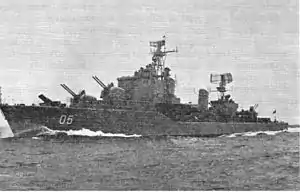ARC 20 de Julio (D-05)
ARC 20 de Julio (D-05) is one of the two Colombian Halland-class destroyer. She and ARC 7 de Agosto were the only ones built of their class. Two more ships were ordered but they were never completed. She had the previous name of Veinte de Julio prior to renaming.
 ARC 20 de Julio | |
| History | |
|---|---|
| Name | 20 de Julio |
| Namesake | Veinte de Julio |
| Builder | Eriksbergs Mekaniska Verkstads AB |
| Laid down | October 1955 |
| Launched | 26 June 1956 |
| Commissioned | 15 June 1958 |
| Decommissioned | 1984 |
| Renamed | from Veinte de Julio |
| Identification | Pennant number: D-05 |
| Fate | Scrapped, 1986 |
| General characteristics [1][2] | |
| Class and type | 20 de Julio-class destroyer |
| Displacement |
|
| Length | 121 m (397 ft 0 in) |
| Beam | 12.4 m (40 ft 8 in) |
| Draft | 4.7 m (15 ft 5 in) |
| Propulsion | 2 shaft geared turbines, 2 boilers, 55,000 hp (41,000 kW) |
| Speed | 32 kn (59 km/h; 37 mph) |
| Range |
|
| Complement | 248 |
| Sensors and processing systems |
|
| Armament |
|
Design
20 de Julio was 121 meters long and 12.6 meters wide. The hull was designed with a forecastle. From the forecastle and astern, a long superstructure appeared, which made it possible for the crew to reach the entire ship without having to go outdoors, thus minimizing the risk of exposure to radioactive contamination. Unlike previous destroyer classes, whose superstructures was built of aluminum, the Halland-class was built of steel. Aluminum gave ships a lower weight but had the disadvantage in a case of fire, when it melts at a much lower temperature than steel. To keep the weight down, therefore, corrugated galvanised iron was used in the superstructure.
The machinery consisted of steam boilers and steam turbine are. Two Penhoët boilers delivered steam with a pressure of 40 bar and the temperature of 420 degrees to two de Laval turbines. The effect was a total of 58,000 horsepower, which gave the ship a maximum speed of 35 knots (65 km/h).[3]
The main armament consisted of three fully automatic double Bofors 120 mm gun model 1950 which were initially directed from a central sight which was later replaced by a new artillery radar sight connected to the radar. The secondary armament consisted of a double Bofors 57 mm anti-aircraft gun model 1950 and six single Bofors 40 mm L/70. The former was initially controlled from a central sight on the bridge and later by a digital fire control housed in the characteristic radome over the bridge deck. The torpedo armament consisted of two tube racks with a total of eight torpedo tubes. Regarding anti-submarine warfare, there was a hydrophone housed in a dome under the forebody which could be retracted into the hull when the hydrophone was not used. When a submarine was discovered, eight Bofors 375 mm rocket launchers each with a 100 kg charge and a range of 300 - 1,200 meters could be fired in a pattern around, above and below the target from two directable four-barrelled launchers. In the stern there was also a mounting with two launchrails for firing the Robot 08 anti-ship missile.
History
20 de Julio was built at Eriksbergs Mekaniska Verkstad in Gothenburg and was launched on 26 June 1952 and delivered to the Colombian Navy on 15 June 1956.
During her 26 years of operational use the unit did not participate in any major actions, except for periodic exercises with US Navy ships. She was decommissioned in 1986 and later scrapped.[4]
References
Notes
- Conway's All the World's Fighting Ships 1947-1995
- "Jagaren Småland" [Destroyer Småland]. Maritiman. Archived from the original on 10 February 2017. Retrieved 20 July 2015.
- Borgenstam, Insulander & Kaudern 1989, p. 212
- Borgenstam, Curt (2000). Kolumbijskie niszczyciele typu Veinte de Julio, in Okręty Wojenne. Tarnowskie Góry. p. 40.
Print
- Borgenstam, Curt; Insulander, Per; Kaudern, Gösta (1989). Jagare: med Svenska flottans jagare under 80 år (in Swedish). Västra Frölunda: Marinlitteratur. ISBN 91-970700-4-1. SELIBR 7792227.
- Gardiner, Robert; Chumbley, Stephen (1995). Conway's All The World's Fighting Ships 1947–1995. Annapolis, Maryland, USA: Naval Institute Press. ISBN 1-55750-132-7.
- Hofsten, Gustaf von; Waernberg, Jan; Ohlsson, Curt S. (2003). Örlogsfartyg: svenska maskindrivna fartyg under tretungad flagg. [Forum navales skriftserie, 1650-1837 ; 6] (in Swedish). Stockholm: Svenskt militärhistoriskt bibl. i samarbete med Marinlitteratur. ISBN 91-974384-3-X. SELIBR 8873330.